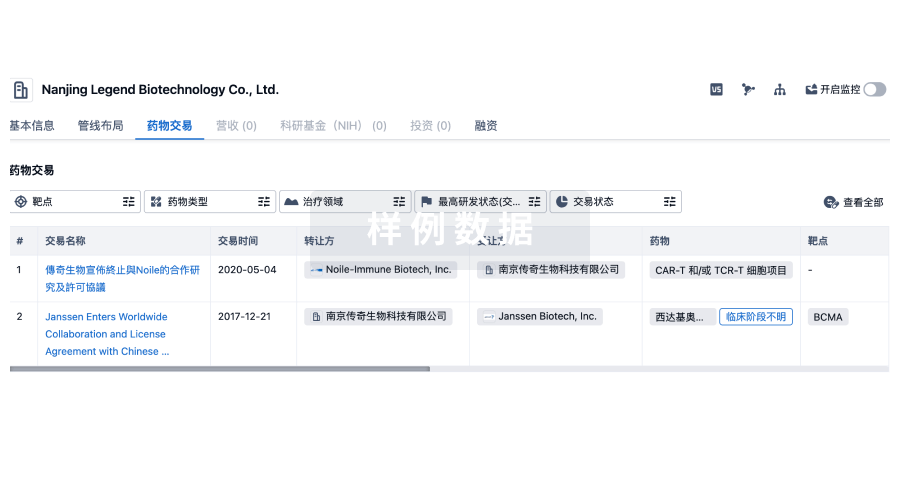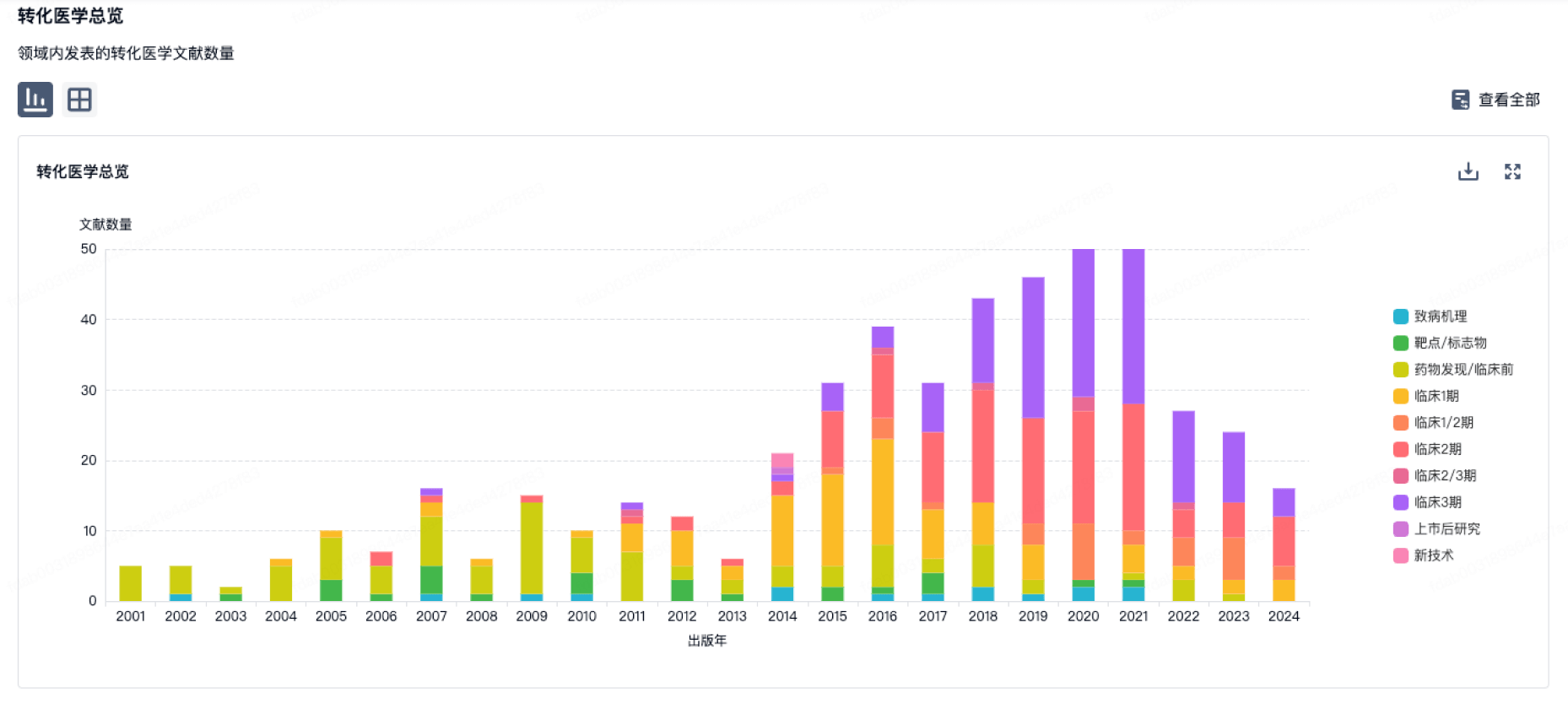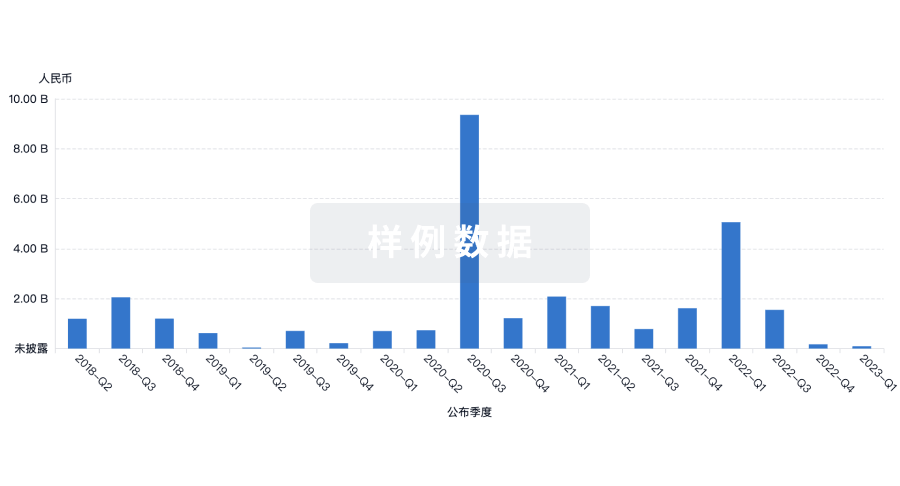预约演示
更新于:2025-11-08

The University of Hong Kong Shenzhen Hospital
更新于:2025-11-08
概览
标签
肿瘤
消化系统疾病
其他疾病
小分子化药
ADC
疾病领域得分
一眼洞穿机构专注的疾病领域
暂无数据
技术平台
公司药物应用最多的技术
暂无数据
靶点
公司最常开发的靶点
暂无数据
| 疾病领域 | 数量 |
|---|---|
| 肿瘤 | 2 |
| 排名前五的药物类型 | 数量 |
|---|---|
| 小分子化药 | 1 |
| ADC | 1 |
| 排名前五的靶点 | 数量 |
|---|---|
| LDHC(lactate dehydrogenase C) | 1 |
| CD276 x Tubulin | 1 |
关联
2
项与 香港大学深圳医院(深圳市滨海医院) 相关的药物作用机制 CD276抑制剂 [+1] |
在研适应症 |
非在研适应症- |
最高研发阶段临床前 |
首次获批国家/地区- |
首次获批日期- |
CN118515686
专利挖掘靶点 |
作用机制 LDHC inhibitors |
在研适应症 |
非在研适应症- |
最高研发阶段药物发现 |
首次获批国家/地区- |
首次获批日期- |
155
项与 香港大学深圳医院(深圳市滨海医院) 相关的临床试验ChiCTR2500111609
Multi-Agent LLM-powered Collaborative Outpatient Care on Heart Failure Patients: A Multicenter Randomized Controlled Trial
开始日期2025-11-01 |
申办/合作机构  香港大学深圳医院(深圳市滨海医院) 香港大学深圳医院(深圳市滨海医院) [+1] |
NCT07013461
International Collaborative Study to Develop the AJCC/UICC TNM Version-Ten for Nasopharyngeal Cancer
The goal of this international, multicenter, prospective observational study is to improve prognostication and prediction of failure pattern for nasopharyngeal carcinoma (NPC), in order to provide more accurate guidance for personalized treatment decision. Firstly, we aim to improve the fundamental TNM staging system (current AJCC/UICC TNM Version-Nine) based on universally assessable anatomical parameters. Secondly, we aim to further refine prognostication for individual patients by integrating anatomical TNM parameters with non-anatomical factors and molecular biomarkers. In addition to the core group of participating centers from China (including Hong Kong) where NPC is most prevalent, the study will enrol patients from multiple countries/regions including those from non-endemic areas to provide global data. Patients treated with contemplary treatment methods during October 2025 to September 2026 will be recruited and they will be followed up for 5 years to generate detailed records for robust evaluation.
Key Questions:
* To achieve optimal improvement of anatomically based AJCC/UICC TNM Classification for global application
* To achieve precise prediction of failure pattern for individual patients by integration of TNM system and non-anatomical prognostic factors/molecular biomarkers Recruited patients with confirmed histological diagnosis of NPC will undergo standard clinical evaluations and receive treatment per institutional guidelines.
The anatomical extent of disease at presentation will be evaluated by experienced radiologists and oncologists. The patient will be followed up for 5 years and clinical outcome will be recorded for analyses on correlation with prognostic factors.
This study will be another important milestone for NPC staging because firstly, this is the first time that the data are based on prospective data to ensure comprehensive coverage of all essential evidence; and secondly, this is the first time that centers from non-endemic countries/regions will also participate to ensure that the final recommendations are globally applicable. The findings will provide valuable evidence for the development of the AJCC/UICC TNM Version-Ten staging system and prognostic system to improve risk stratification for designing personalized treatment strategy, ultimately leading to improvement of patient outcome and patient selection for future research worldwide.
Key Questions:
* To achieve optimal improvement of anatomically based AJCC/UICC TNM Classification for global application
* To achieve precise prediction of failure pattern for individual patients by integration of TNM system and non-anatomical prognostic factors/molecular biomarkers Recruited patients with confirmed histological diagnosis of NPC will undergo standard clinical evaluations and receive treatment per institutional guidelines.
The anatomical extent of disease at presentation will be evaluated by experienced radiologists and oncologists. The patient will be followed up for 5 years and clinical outcome will be recorded for analyses on correlation with prognostic factors.
This study will be another important milestone for NPC staging because firstly, this is the first time that the data are based on prospective data to ensure comprehensive coverage of all essential evidence; and secondly, this is the first time that centers from non-endemic countries/regions will also participate to ensure that the final recommendations are globally applicable. The findings will provide valuable evidence for the development of the AJCC/UICC TNM Version-Ten staging system and prognostic system to improve risk stratification for designing personalized treatment strategy, ultimately leading to improvement of patient outcome and patient selection for future research worldwide.
开始日期2025-10-01 |
申办/合作机构  香港大学深圳医院(深圳市滨海医院) 香港大学深圳医院(深圳市滨海医院) [+13] |
NCT07201337
A Randomized, Open-Label, Non-Inferiority Phase III Multicenter Clinical Trial Comparing Reduced-Dose to Standard-Dose Prophylactic Irradiation for Low-Risk Clinical Target Volume (CTV) in the Treatment of Nasopharyngeal Carcinoma.
To evaluate the locoregional control, survival rate, toxicity, and quality of life in patients with nasopharyngeal carcinoma treated with reduced prophylactic irradiation doses to the Low-Risk Clinical Target Volume (CTV).
开始日期2025-09-01 |
申办/合作机构  中山大学 中山大学 [+5] |
100 项与 香港大学深圳医院(深圳市滨海医院) 相关的临床结果
登录后查看更多信息
0 项与 香港大学深圳医院(深圳市滨海医院) 相关的专利(医药)
登录后查看更多信息
519
项与 香港大学深圳医院(深圳市滨海医院) 相关的文献(医药)2025-12-31·Emerging Microbes & Infections
Reverse genetics-derived cattle H5N1 virus from Clade 2.3.4.4b shows enhanced systemic infectivity and pathogenicity than an older Clade 1 H5N1 virus in BALB/c mice
Article
作者: Chung, Howard Chun-Ho ; Kok, Kin-Hang ; Xiao, Na ; Li, Can ; Chan, Jasper Fuk-Woo ; Chen, Honglin ; Song, Wenchen ; Wang, Pui ; Chu, Hin ; Ye, Zhanhong ; Oong, Xiang Yong ; Yuan, Shuofeng ; Lam, Alvin Hiu-Chung ; Lee, Andrew Chak-Yiu ; Chen, Yanxia ; Cai, Jianpiao ; Yuen, Kwok-Yung ; Zhang, Anna Jin-Xia
The newly emerged avian influenza A H5N1 Clade 2.3.4.4b can infect dairy cows and shed live virus in their milk. Sporadic cattle-to-human infections have been reported, highlighting the urgent need to understand its pathogenesis in mammals. Using both non-lactating and lactating BALB/c mice, we examined the viral tissue tropism, histopathological damages, and host immune responses upon intranasal inoculation with a reverse-genetic virus constructed based on A/dairy cattle/Texas/24-008749-003/2024 (Cattle-H5N1) and comparing with an older reference Clade 1 virus, A/Vietnam/1194/2004 virus (VNM1194-H5N1). Cattle-H5N1 was highly lethal in mice (mLD50 = 1.48PFU) with broad tissue tropism and produced higher titer in respiratory tissue and multiple extrapulmonary organs than VNM1194-H5N1. In the lungs, Cattle-H5N1 infection of airway epithelium, type II pneumocytes and CD45+ immune cells were at a higher frequency than those of VNM1194-H5N1-infected mice, resulting in severe epithelial destruction and diffuse alveolar damage accompanied by elevated lung and serum pro-inflammatory cytokine/chemokines. Although both H5N1 viruses showed lactating mammary gland tropism, the gland tissue was more severely damaged after Cattle-H5N1 infection with abundant viral antigens expression in glandular cells, associated fat and lymphoid tissues. Furthermore, more suckling mice co-housed with Cattle-H5N1 infected lactating mice were virus-positive (7/30 pups) than VNM1194-H5N1. Brains were heavily infected by Cattle-H5N1, and neurological signs such as body-rolling/spinning, trembling and/or limb paralysis were seen only in Cattle-H5N1 infected mice. The spleen was more severely damaged by Cattle-H5N1 infection, which showed massive viral antigen expression accompanied by severe apoptosis and splenic atrophy, concluding that Cattle-H5N1 is more virulent in mice than VNM1194-H5N1.
2025-12-31·AUTOIMMUNITY
Identification of cellular senescence-associated hub genes and molecular targeting mechanisms of thalidomide in lupus nephritis (LN)
Article
作者: Cui, Shengjin ; Zhang, Guowen ; Li, Wanting ; Zhang, Ji ; Tan, Lin ; Peng, Huidi ; Xie, Jingjing ; Jiang, Lu ; Li, Yanting ; Ye, Yunyun ; Huang, Dongfang
Systemic lupus erythematosus (SLE), a chronic autoimmune disease, progresses to lupus nephritis (LN) in 50-60% of patients, driving end-stage renal disease (ESRD). Identifying LN-associated cellular senescence hub genes and drug targets is critical for elucidating pathogenesis and advancing targeted therapies. Integrated transcriptomic data from LN patients (GSE61635, GSE121239; n = 441) were analyzed to identify differentially expressed genes (DEGs) using the limma package (|log2FC| > 0.5 and FDR < 0.05). Cellular senescence-associated differentially expressed genes (CS-DEGs) were further filtered through hypergeometric testing using the CellAge database. Functional enrichment analysis performed with ClusterProfiler and DOSE packages revealed significantly enriched pathways based on GO, KEGG, and GSEA terms (FDR < 0.05). A protein-protein interaction (PPI) network was constructed using STRING data and visualized in Cytoscape to prioritize hub genes. The drug-target interactions of these hub genes were subsequently validated via molecular docking and dynamics simulations using CB-Dock2. A total of 1,098 DEGs (555 upregulated, 543 downregulated) were identified. Functional enrichment revealed 60 CS-DEGs significantly enriched in viral response, myeloid differentiation, and antiviral defense (FDR < 0.05). KEGG analysis highlighted their roles in lipid metabolism/atherosclerosis, NOD-like receptor signaling, and Influenza A. PPI-based topological and modular analyses prioritized CCL2, MYD88, STAT1, JUN, JAK2, and FOS as hub genes, further refined to CCL2, JUN, JAK2, and FOS via ceRNA network. Drug screening identified thalidomide as a potential candidate, with strong binding affinity to all targets, particularly CCL2 (ΔG = -92.7 kcal/mol, forming three stable hydrogen bonds). This study revealed the role of CS-DEGs in viral response, immune regulation, and lipid metabolism in LN. Network analysis prioritized CCL2, JUN, JAK2, and FOS as hub genes. Thalidomide exhibited strong binding to these targets, notably CCL2 (ΔG = -92.7 kcal/mol), suggesting therapeutic potential via CCL2-mediated mechanisms. These findings advance LN pathogenesis understanding and precision-targeted therapies.
2025-12-31·Journal of Pharmaceutical Policy and Practice
Translation and validation of the Pharmacy Services Questionnaire (PSQ) in a Chinese population
Article
作者: Lee, Marco Tsun ; Cho, Tommy Lok Hei ; Cheng, Franco Wing Tak ; Lo, Leo Kin Yip ; Yuen, William Ho Ching ; Sun, Janet Hiu Tung ; Law, Kitty Kit Ki ; Yin Chan, Esther Wai ; Kei Wong, Ian Chi ; Cheung, Chi Lam ; Wong, Janet Kit Ting ; Lee, Tommy Ka Ho ; Ng, Vanessa Wai Sei ; Chan, Frank Nim Kok ; Chen, Timothy F. ; Yiu, Hei Hang Edmund ; Yuen, Reason Pui Yan ; Wan, Eric Yuk Fai ; Daphne Cheung, Gladys
Background:
The Pharmacy Services Questionnaire (PSQ) was developed to measure patient satisfaction with pharmaceutical care. However, it has not been translated into Cantonese-Chinese and validated in the Hong Kong population. To develop and validate a Cantonese-Chinese-translated PSQ among native Chinese patients who have used pharmacy services at community pharmacies in Hong Kong.
Methods:
The PSQ was developed and translated into Cantonese-Chinese using iterative forward-backwards translation. Subjects were recruited by convenience sampling at three community pharmacies. Internal consistency, construct validity, discriminant validity, known-group comparison and Confirmatory Factor Analysis (CFA) were performed to confirm that the Cantonese-Chinese-translated PSQ is a valid measure of its intended constructs. Qualitative think-aloud interviews were carried out to test for comprehension and content validity. The subjects' views and interpretation of each questionnaire item were also explored to determine the relevance, comprehensiveness, and adequacy of the response options.
Results:
A total of 236 adult subjects were recruited to complete the Cantonese-Chinese PSQ and the Chinese 5-Level EuroQol 5-Dimension (EQ-5D-5L HK) questionnaire. Additionally, think-aloud interviews were carried out with 15 subjects. Most subjects were able to understand and interpret the Cantonese-Chinese PSQ with relative ease. The internal consistency of Cantonese-Chinese PSQ was excellent (Cronbach's α > 0.96) for the full-scale, Friendly explanation (FE) subscale and Managing therapy (MT) subscale. CFA confirmed the hypothesised two-factor structure of the Cantonese-Chinese PSQ. Individuals with higher education levels showed statistically significantly higher satisfaction levels in the overall PSQ score and MT scale score compared to those with lower levels of education. Additionally, there was no statistically significant correlation between the Cantonese-Chinese PSQ and EQ-5D-5L HK scores, demonstrating discriminant validity.
Conclusion:
The Cantonese-Chinese translation of the PSQ is a validated, reliable, and semantically equivalent instrument used to assess satisfaction towards services provided by community pharmacies.
44
项与 香港大学深圳医院(深圳市滨海医院) 相关的新闻(医药)2025-11-06
·复星医药
11月6日,第八届中国国际进口博览会(以下简称“进博会”)期间,复星医药以“双擎驱动,破帕新生”为主题,成功举办帕金森病创新治疗方案联合发布会。本次活动汇聚了国内外神经科学领域的权威专家,聚焦帕金森病的诊疗新进展与药械联合治疗新路径,旨在推动帕金森病领域的前沿科技与创新疗法惠及更多中国患者。
发布会通过专家对话、趋势分享与联合发布等环节,全面呈现复星医药在帕金森病领域的前沿布局,包括创新药物“奥吡卡朋”与无创治疗技术复星医视特“磁波刀”等治疗方案,彰显了企业以患者为中心、持续推动医疗创新的坚定承诺。
复星医药首席发展官兼国内营销平台联席董事长徐润红女士在致辞中表示,进博会是中国高水平对外开放的窗口,也是全球创新成果互鉴的平台。此次发布的以创新无创疗法‘磁波刀’与创新药物奥吡卡朋为核心的‘药械协同’创新治疗方案,不仅是复星医药创新成果的一次集中展示,更是响应‘健康中国’战略,助力解决中国神经系统疾病患者、特别是帕金森病患者未尽需求而迈出的坚实一步。
药械协同诊疗,积极应对神经系统疾病
近年来,神经系统疾病患者数量逐年快速上升且呈现出年轻化的趋势,帕金森、脑肿瘤、癫痫等神经系统疾病受到更多关注。聚焦未被满足的临床需求,复星医药积极探索全球领先的创新解决方案。本次发布的“药械协同”帕金森病创新治疗方案,通过创新药物与先进医疗器械的有机结合,为帕金森病患者提供全新治疗选择。
该方案中,创新药品奥吡卡朋作为第三代COMT抑制剂,通过较高的COMT酶结合亲和力,产生强效且持久的抑制活性,从而减少左旋多巴的外周代谢,提高左旋多巴的生物利用度,进一步延长左旋多巴治疗时间及帕金森患者长期获益,为帕金森病运动波动管理提供了新的治疗选择。而磁波刀则是一种融合高强度聚焦超声与磁共振成像的神经治疗技术,该疗法通过MRI精准定位,利用超声消融病灶,无需开颅、无植入物,也不需全身麻醉,为震颤及帕金森病患者提供了一种治疗新选择。
专家视角:从诊疗前沿到临床实践
左右滑动查看更多
在专家分享环节,上海交通大学医学院附属瑞金医院的神经内科专家就“帕金森病诊疗新进展”展开专业分析,从药物研发与临床应用角度展望治疗方向。磁波刀技术在中国应用的重要推动者、香港大学深圳医院李勇杰教授则结合临床实践,分享了“磁波刀在帕金森病治疗中的前沿应用与潜力”。
聚焦国际视野,Insightec学术研究副总裁Yeruham Shapira先生分享了“MRgFUS Treatment for PD - path and status”,介绍了帕金森病超声治疗的全球经验与技术进展。
联合发布:开启“双擎驱动”新里程
在发布会仪式环节,香港大学深圳医院李勇杰教授,复星医药首席发展官兼国内营销平台联席董事长徐润红女士,复星医药副总裁、复星医疗器械联席CEO 吕力琅女士,复星医视特总经理邱鹏先生,复星医药国内营销平台联席总裁兼战略市场部总经理刘焰女士,Insightec Academic Research Vice President Yeruham Shapira先生共同见证这一重要时刻。这不仅标志着复星医药在帕金森病领域创新治疗方案的全面落地,也象征着企业携手专家、医疗机构与行业伙伴,有望共同推动中国帕金森病诊疗水平迈上新台阶。
未来,复星医药将继续秉持“持续创新、乐享健康”的理念,探索神经科学领域前沿科技,携手各界力量,共同为推进“健康中国2030”注入新动能、开拓新格局。
免责声明:本文仅作新闻用途,不应被视为对所涉医疗产品的推荐或功效证明。涉及疾病诊断、治疗、康复相关的,请务必前往专业医疗机构就诊,寻求专业意见。本文使用的相关观点、肖像已获得相应授权。
孤儿药
2025-10-25
·凤凰网
2025年10月25日上午,由中国医学装备协会皮肤病与皮肤美容分会主办、南方医科大学深圳医院、安徽医科大学第一附属医院共同承办的第八届银屑病大会在广东省深圳市正式开幕。本次大会主题是“银屑病及其共病—洞悉多米诺效应”。开幕式由来自南方医科大学深圳医院梁燕华教授和华北理工大学孙良丹教授主持。来自南方医科大学深圳医院满强党委书记,亚太银友会会长Josef先生,CPC银屑病大会发起人张学军教授,空军军医大学西京医院王刚教授,中南大学常务副校长陈翔教授,华北理工大学党委副书记孙良丹教授,新疆维吾尔自治区人民医院副院长康晓静教授,瑞士洛桑大学医院Curdin Conrad教授,印度尼西亚Rudi Chandra教授,梅奥医学院David Men教授,健康报、健康中国传播发展中心李天舒主任,上海市皮肤病医院副院长史玉玲教授,上海交通大学医学院附属瑞金医院郑捷教授,浙江大学医学院附属第二医院郑敏教授、深圳大学南山医院刘晓明教授,大连市皮肤病医院院长吕成志教授,哈尔滨医科大学第二附属医院栗玉珍教授、广州市皮肤病医院张锡宝教授、安徽医科大学第一附属医院杨森教授、王再兴教授、华北理工大学附属医院杨洁教授等国内外银屑病领域多位专家学者、临床医生、研究人员、媒体人士及患者代表850余位及线上60余万人次出席本次会议,共同研讨银屑病基础与临床的前沿进展及科研思路,分享银屑病预防与诊疗的实践经验,助力皮肤科医生更规范地开展银屑病的科普宣教、疾病管理、预防干预、精准诊断及规范治疗工作。精彩内容将由凤凰网、百度、腾讯、网易、深圳卫视都市频道、香港商报凤凰网、易视频、新浪报道,并通过医我行、优麦、医学界、CCMTV同步直播。第八届银屑病大会现场首先张学军教授代表第八届银屑病大会(CPC)组委会和国际银屑病协会(IPC)对各位专家学者及与会者的到来表示感谢,并回顾了从第一届到第七届银屑病大会的历程,各届主题逐步深化,成果丰硕,并且随着银屑病创新药物不断涌现,越来越多患者得到临床治愈,使银屑病成为一种可治愈疾病,这也是举办银屑病大会的意义所在。高度肯定了本届会议在参会规模、内容深度、学科跨度、国际化程度等方面均取得了很大的突破与创新,最后对承办会议的梁燕华教授团队表示感谢。张学军教授致辞来自南方医科大学深圳医院满强书记首先对所有专家同道的到来,及对支持南方医科大学深圳医院及皮肤科发展的各位同仁表示感谢,介绍了南方医科大学深圳医院在医、教、研方面取得的成绩,并预祝本次大会取得圆满成功。满强书记致辞亚太银友会CEO、IFPA理事Josef先生致辞对银屑病大会的召开予以祝贺,肯定了中国在银屑病基础和临床领域的重大贡献,并期待未来继续保持密切合作。Josef先生致辞本次大会举行了粤港澳大湾区银屑病联盟成立的揭牌仪式,在粤港澳大湾区,108家医院的皮肤科众志成城、团结一致,连续3年开展了规模浩大、整齐划一的银屑病义诊和各种形式的患教活动,创新性强,影响力大,受到了银屑病大会组委会的鼓励和肯定,并批准成立粤港澳大湾区银屑病联盟,支持在大湾区开展银屑病的患者教育、管理、基础及临床研究等工作。粤港澳大湾区银屑病联盟揭牌开幕式同时还发布了《中国银屑病患者自我管理手册》,该手册涵盖疾病认知、日常护理、心理调节、治疗依从性等实用内容,填补了患者自我管理工具的空白,未来,这本手册将通过全国医院、社区卫生服务中心及线上平台,免费传递到千千万万患者手中,让每一位银屑病患者,都能科学、自信地管理自己的生活,真正实现——“与银共生,自在生活”。《中国银屑病患者自我管理手册》发布梁燕华教授和孙良丹教授主持开幕式在安徽医科大学第一附属医院王再兴教授、周伏圣教授,北京大学深圳医院于波教授,江苏省人民医院尹志强教授,深圳市宝安区慢性病防治院邓宝清教授的主持下,多位国内知名银屑病专家就银屑病最新的科研转化、风险因素、创新药物及精准治疗进行了大会报告。张学军教授做了“银屑病生物制剂治疗,博鳌先行先试到全国推广应用”的大会报告,从千百年来“医不治癣,治癣就丢脸”的困境,到发现银屑病遗传规律、易感基因和生物学机制,再到在博鳌先行先试政策下,多款创新生物制剂的临床数据与应用经验,体现了我国银屑病转化医学的工作。空军军医大学西京医院王刚教授做了关于“关节病型银屑病的早期筛查与治疗”的报告,关节病型银屑病(PsA)作为银屑病的特殊类型,其临床表现的多样性,如何早期通过识别症状及高危发病因素进行PsA诊断,并针对不同发病阶段进行干预,生物制剂和小分子药物可作为一线治疗,并对患者进行多维度管理。中南大学湘雅医院陈翔教授做了关于“针对银屑病领域关键问题的临床研究”的报告,针对银屑病流行病学规律不清、疾病异质性、缺乏精准治疗及停药复发等临床问题出发进行原创性研究,构建了整个银屑病精准防-诊-治研究体系。专题会版块,来自上海市皮肤病医院史玉玲教授汇报了关于“先发制人,双效合一司库奇尤单抗有效拦截PsO 向银屑病关节炎进展各阶段”,香港大学深圳医院的张振颖教授“银屑病治疗‘双重奏’--再思考IL-12、23 双靶点干预的临床获益”,中南大学湘雅三医院鲁建云教授“生物制剂应答不佳/不耐受Pso患者的用药方案”,广州市皮肤病医院张锡宝教授“安心速达,清静致远-银屑病生物制剂治疗3.0时代”及安徽医科大学第一附属医院朱正伟教授“循证夯实获益,剂型突破桎梏甲氨蝶呤治疗银屑病进展研究”,分享了最新前沿的诊疗进展。本次大会设有“银屑病基础研究专场”、“银屑病临床研究专场”、“银屑病中西医治疗专场”、“银屑病青年专场”、“银屑病复发专场”、“银屑病基层专场”、“银屑病交叉学科专场”、“银屑病转化专场”、“International Sessionon: Psoriasis”和“亚太银屑病患者组织专场”共十大专场,汇聚了国内外大批权威专家学者,他们从多元视角、多维度层面进行专业分享,共同打造了一系列精彩纷呈的学术盛会,针对银屑病领域的前沿研究成果开展深度探讨,交流诊疗实践中的珍贵经验,以及科学研究中的创新思路与先进方法,以期提高我国银屑病临床诊疗能力,为国内数百万银屑病患者送去更多健康希望。来源:CPC2025审核:雷可可
2025-10-16
点击蓝字
关注我们
编者按
胰腺癌作为全球最致命的恶性肿瘤之一,其5年生存率仅为5%~15%。由于早期症状隐匿、缺乏精准生物标志物,多数患者确诊时已处于晚期,仅有15%~20%具备手术切除资格,预后极差。2型糖尿病是胰腺癌明确的危险因素之一,但血糖控制水平对长期糖尿病患者胰腺癌发生风险的具体影响,此前尚不明确。中国香港大学司徒伟基教授和中国香港大学玛丽医院张嘉盛教授团队近期发表于Gut的一项基于人群的大规模队列研究,首次系统探讨了长期T2D患者血糖控制与胰腺癌风险的关联,为这一临床难题提供了关键证据。
01
错综复杂的糖尿病与胰腺癌之间的关联
长期以来,流行病学证据表明,2型糖尿病可使胰腺癌的风险增加约两倍。然而,这种关系是双向且复杂的。一方面,长期存在的糖尿病(>3年)被认为是胰腺癌的致病风险因素,其机制可能涉及慢性高血糖导致的氧化应激和炎症状态、胰岛素抵抗引发的高胰岛素血症,进而激活PI3K/Akt/mTOR等促癌信号通路。
另一方面,胰腺癌本身可导致新发糖尿病(通常在癌症诊断前3年内出现,称为3c型糖尿病),这被认为是胰腺癌的早期副癌综合征。因此,若在研究中将新发糖尿病患者纳入分析,会引入严重的反向因果关系,即其实是未被发现的胰腺癌导致了血糖恶化,从而高估糖尿病本身的致病风险。
此前的研究大多未能有效区分长期糖尿病与新发糖尿病,且普遍存在样本量小、多依赖单次血糖或糖化血红蛋白(HbA1c)测量、未能充分调整重要混杂因素(如糖尿病并发症、合并用药等)的局限。因此,在长期2型糖尿病患者中,血糖控制水平是否为一个可改变的胰腺癌风险因素,始终是一个悬而未决的关键科学问题。
02
研究设计:严谨的大规模队列研究方案
为解决上述问题,研究团队采用回顾性队列设计,基于香港医院管理局的临床数据分析与报告系统(CDARS)构建研究人群。该数据库涵盖全港医疗记录,包括人口学特征、诊断、实验室结果、处方信息等,数据有效性已在多项人群研究中验证。
纳入标准为2001-2015年新诊断的T2D患者(≥18岁),具备体重指数(BMI)数据,且至少有2次HbA1c测量记录。此外,为避免反向因果,排除T2D诊断后3年内确诊胰腺癌的患者;同时排除既往胰腺癌、IgG4相关性疾病、胰腺切除术史以及随访时间不足3年的患者(图1)。
图1. 患者选择
最终纳入458331例长期T2D患者,中位年龄59.8岁(IQR:51.8~68.5岁),男性占51.2%,中位随访时间9.9年(IQR:7.4~14.1年)。
本研究的一大亮点是采用了时间加权平均HbA1c和空腹血糖(FG) 作为暴露指标。与传统单点测量不同,该方法考虑了整个随访期间所有不规则的血糖测量值,并通过时间间隔进行加权,从而更准确地反映了患者长期的、动态的血糖控制水平。最优血糖控制定义为:时间加权平均HbA1c<7%(主要暴露指标)或FG≤7mmol/L(次要暴露指标),反之则为次优控制。
主要结局为胰腺癌发病;次要结局为胰腺癌相关死亡和全因死亡。
研究者采用Cox比例风险模型计算调整后风险比(aHR),通过倾向得分(PS)匹配平衡年龄、性别、BMI、吸烟、并发症、药物使用等混杂因素;同时开展敏感性分析、剂量反应分析及亚组分析。
03
核心研究结果:血糖控制显著降低胰腺癌风险
随访期间共发生1382例胰腺癌(发生率2.8/10万人年)、922例胰腺癌相关死亡(1.9/10万人年)及70936例全因死亡(142.9/10万人年)。
研究发现,与血糖控制不佳(≥7%)的患者相比,实现最优HbA1c控制(<7%)的患者胰腺癌发生风险降低了57%(aHR=0.43,95%CI:0.37~0.48);最优FG控制(≤7 mmol/L)与风险降低29%相关(aHR=0.71,95%CI:0.63~0.80)(表1)。同时实现HbA1c<7%和FG≤7 mmol/L的患者,胰腺癌风险最低(aHR=0.39,95%CI:0.33~0.46)。
表1. 血糖控制与胰腺癌发病、胰腺癌相关死亡及全因死亡之间的关联
随着HbA1c水平升高,胰腺癌风险呈阶梯式上升(趋势P<0.001):与HbA1c<7%相比,HbA1c 7.0%~7.5%者风险增加85%(aHR=1.85),HbA1c≥9%者风险增加3.6倍(aHR=4.61)。此外,HbA1c每升高1%,胰腺癌风险增加46%(aHR=1.46,95%CI:1.39~1.53);FG每升高1 mmol/L,风险增加14%(aHR=1.14,95%CI:1.11~1.17)。这一发现强有力地支持了高血糖与胰腺癌风险之间的生物学梯度,表明任何程度的血糖改善都可能带来获益。
最优HbA1c控制不仅降低胰腺癌发病风险,还与胰腺癌相关死亡风险降低65%(aHR=0.35,95%CI:0.30~0.41)、全因死亡风险降低17%(aHR=0.83,95%CI:0.82~0.85)相关(表1);最优FG控制同样与胰腺癌相关死亡风险降低31%相关(aHR=0.69,95%CI:0.59~0.79)。
亚组分析显示,无论患者年龄(<65岁或≥65岁)、性别、BMI(<25 kg/m2或≥25kg/m2)、吸烟状态、是否合并并发症,最优血糖控制的保护效应均一致存在。敏感性分析后,结果仍保持显著,证实研究结论的稳健性。
观点分享
对于长期罹患2型糖尿病的患者而言,维持最优血糖控制是降低胰腺癌发生及相关死亡风险的一个独立且可改变的重要保护因素。血糖水平与胰腺癌风险之间存在强烈的剂量-反应关系,同时控制HbA1c和空腹血糖能带来最显著的获益。这些发现将血糖管理的临床意义提升到了一个新的高度,为其作为胰腺癌预防性策略提供了强有力的证据支持,有望对未来糖尿病管理指南的更新和临床决策产生深远影响。
参考文献:Tan JT, Mao X, Lui DT, et al. Glycaemic control is a modifiable risk factor for pancreatic cancer development in patients with diabetes: a population-based cohort study. Gut. Published online September 18, 2025. doi:10.1136/gutjnl-2025-335837
专家简历
司徒伟基教授
中国香港大学
教授,医学博士,肠胃肝脏科专科医生,现为香港大学内科学系肠胃肝脏科临床教授,肝病研究国家重点实验室(香港大学)主要研究员,香港大学深圳医院消化内科教研主管及主任医师,港大医学院助理院长(跨领域协作)。根据《科睿唯安》,司徒教授自2020起每年名列全球学者前1%,他发表的多于300份论文,是在多份高影响力的国际性期刊刊登,包括以第一或通讯作者身份的Lancet,Journal of Clinical Oncology、Lancet Global Health、Journal of Hepatology、Gut、Hepatology等。司徒教授的研究大多与慢性肝病有关,特别是病毒性肝炎、脂肪肝和肝癌。
张嘉盛 教授
中国香港大学玛丽医院
他也是香港玛丽医院和香港大学深圳医院的名誉顾问。他于2016年获颁Professor Anthony Hedley公共卫生最高荣誉奖,并于 2020 年获颁 Sir Patrick Manson 医学博士金奖。
张教授已发表了超过140篇期刊文章(h指数:39;>6600次引用). 其中包括Gastroenterology、Gut、Diabetes Care、Clinical Gastroenterology&Hepatology和Journal of the National Cancer Institute杂志。
他也受邀发表超过60场演讲,包括 2023 年亚太消化周APDWF-JGHF (Asia Pacific Digestive Week Federation-Journal of Gastroenterology and Hepatology Foundation) 新兴领袖讲座以及其他全体口头会议和最新技术讲座。此外,他还受邀担任Journal of Hepatology、Gastroenterology、Gut、eClinicalMedicine和Clinical Gastroenterology&Hepatology等同行评审期刊的审稿人。
张教授获得了30个国际和本地奖项,包括2021年欧洲消化疾病周(United European Gastroenterology Week)国家学者奖和2017年亚太消化周(Asia Pacific Digestive Week)APDWF-JGHG青年研究者奖。
(来源:《肿瘤瞭望》编辑部)
声 明
凡署名原创的文章版权属《肿瘤瞭望》所有,欢迎分享、转载。本文仅供医疗卫生专业人士了解最新医药资讯参考使用,不代表本平台观点。该等信息不能以任何方式取代专业的医疗指导,也不应被视为诊疗建议,如果该信息被用于资讯以外的目的,本站及作者不承担相关责任。
临床结果临床研究临床终止
100 项与 香港大学深圳医院(深圳市滨海医院) 相关的药物交易
登录后查看更多信息
100 项与 香港大学深圳医院(深圳市滨海医院) 相关的转化医学
登录后查看更多信息
组织架构
使用我们的机构树数据加速您的研究。
登录
或

管线布局
2025年12月17日管线快照
管线布局中药物为当前组织机构及其子机构作为药物机构进行统计,早期临床1期并入临床1期,临床1/2期并入临床2期,临床2/3期并入临床3期
药物发现
1
1
临床前
登录后查看更多信息
当前项目
| 药物(靶点) | 适应症 | 全球最高研发状态 |
|---|---|---|
BH1-DM1 ( CD276 x Tubulin ) | 食管鳞状细胞癌 更多 | 临床前 |
CN118515686 ( LDHC )专利挖掘 | 肿瘤 更多 | 药物发现 |
登录后查看更多信息
药物交易
使用我们的药物交易数据加速您的研究。
登录
或

转化医学
使用我们的转化医学数据加速您的研究。
登录
或

营收
使用 Synapse 探索超过 36 万个组织的财务状况。
登录
或

科研基金(NIH)
访问超过 200 万项资助和基金信息,以提升您的研究之旅。
登录
或

投资
深入了解从初创企业到成熟企业的最新公司投资动态。
登录
或

融资
发掘融资趋势以验证和推进您的投资机会。
登录
或

生物医药百科问答
全新生物医药AI Agent 覆盖科研全链路,让突破性发现快人一步
立即开始免费试用!
智慧芽新药情报库是智慧芽专为生命科学人士构建的基于AI的创新药情报平台,助您全方位提升您的研发与决策效率。
立即开始数据试用!
智慧芽新药库数据也通过智慧芽数据服务平台,以API或者数据包形式对外开放,助您更加充分利用智慧芽新药情报信息。
生物序列数据库
生物药研发创新
免费使用
化学结构数据库
小分子化药研发创新
免费使用